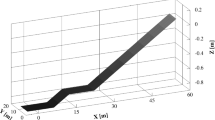Abstract
This study, part of the Special Issue dedicated to the 70th anniversary of Professor Efim Pelinovsky, focuses on a topic that has been central in Professor Pelinovsky’s research, i.e. the analytical and numerical modelling of shallow water waves. We specifically focus on the evolution of trains of shock waves on a planar beach. Antuono (J Fluid Mech 658:166–187, 2011) has, for the first time, proposed a quasi-analytical solution for a train of shock waves forced by a constant Riemann invariant. The present contribution clarifies the validity of such solution and its value for benchmarking nonlinear shallow water equation solvers. Hence, the same tests of Antuono (J Fluid Mech 658:166–187, 2011) have been run by means of the solver of Brocchini et al. (Coast Eng 43(2):105–129, 2001) revealing surprisingly and reassuring good agreements. This provides significant support to the mentioned analytical solution and allows to critically analyse the eventual discrepancies, due to the practicalities of running numerical shallow water solutions (e.g. influence of the boundary conditions, of the numerical resolution, etc.).









Similar content being viewed by others
References
Antuono M (2010) A shock solution for the nonlinear shallow water equations. J Fluid Mech 658:166–187
Antuono M (2011) Shock trains on a planar beach. J Fluid Mech 686:583–606
Antuono M, Brocchini M (2007) The boundary value problem for the nonlinear Shallow Water equations. Stud Appl Math 119:73–93
Antuono M, Brocchini M (2010) Solving the nonlinear shallow-water equations in physical space. J Fluid Mech 643:207–232
Ata R, Pavan S, Khelladi S, Toro EF (2013) A Weighted Average Flux (WAF) scheme applied to shallow water equations for real-life applications. Adv Water Res 62:155–172
Briganti R, Dodd N (2009) Shoreline motion in nonlinear shallow water coastal models. Coast Eng 56(5–6):495–505
Brocchini M, Gentile R (2001) Modelling the run-up of significant wave groups. Cont Shelf Res 21(15):1533–1550
Brocchini M, Bernetti R, Mancinelli A, Albertini G (2001) An efficient solver for nearshore flows based on the WAF method. Coast Eng 43(2):105–129
Clawpack Development Team: Clawpack software, 2015, http://www.clawpack.org. Version 5.3.0
Didenkulov O, Didenkulova I, Pelinovsky E (2015) Parameterization of run-up characteristics for long bell-shaped solitary waves propagating in a bay of parabolic cross-section. Proc Estonian Acad Sci 64(3):234–239
Didenkulova I, Pelinovsky E (2011a) Runup of tsunami waves in U-shaped bays. Pure Appl Geophys 168(6–7):1239–1249
Didenkulova I, Pelinovsky E (2011b) Nonlinear wave evolution and runup in an inclined channel of a parabolic cross-section. Phys Fluids 23(8):086602
Didenkulova II, Pelinovsky EN, Didenkulov OI (2014) Run-up of long solitary waves of different polarities on a plane beach, Izvest. Atmos Ocean Phys 50(5):532–538
Le Roy S, Pedreros R, André C, Paris F, Lecacheux S, Marche F, Vinchon C (2015) Coastal flooding of urban areas by overtopping: dynamic modelling application to the Johanna storm (2008) in Gâvres (France). Nat Hazards Earth Syst Sci 15:2497–2510
Rybkin A, Pelinovsky E, Didenkulova I (2014) Nonlinear wave run-up in bays of arbitrary cross-section: generalization of the Carrier-Greenspan approach. J Fluid Mech 748:416–432
Toro E (2000) Shock-capturing methods for free-surface shallow flows. Wiley, Chichester
Torres-Freyermuth A, Mariño-Tapia I, Coronado C, Salles P, Medellín G, Pedrozo-Acuña A, Silva R, Candela J, Iglesias-Prieto R (2012) Wave-induced extreme water levels in the Puerto Morelos fringing reef lagoon. Nat Hazards Earth Syst Sci 12:3765–3773
Zijlema M, Stelling GS, Smit P (2011) SWASH: an operational public domain code for simulating wave fields and rapidly varied flows in coastal waters. Coast Eng 58(10):992–1012
Acknowledgments
This work has been funded by the Flagship Project RITMARE—the Italian Research for the Sea—coordinated by the Italian National Research Council and funded by the Italian Ministry of Education, University and Research within the National Research Program 2011. Support from the EsCoSed Project, financed by the US-ONR through the NICOP Research Grant (N62909-13-1-N020), is gratefully acknowledged.
Author information
Authors and Affiliations
Corresponding author
Rights and permissions
About this article
Cite this article
Soldini, L., Antuono, M. & Brocchini, M. Shock trains on a planar beach: quasi-analytical and fully numerical solutions. Nat Hazards 84 (Suppl 2), 621–635 (2016). https://doi.org/10.1007/s11069-016-2343-8
Received:
Accepted:
Published:
Issue Date:
DOI: https://doi.org/10.1007/s11069-016-2343-8




